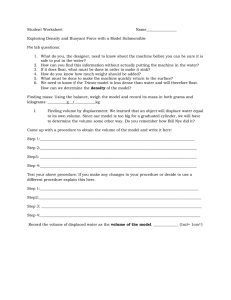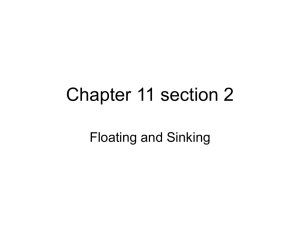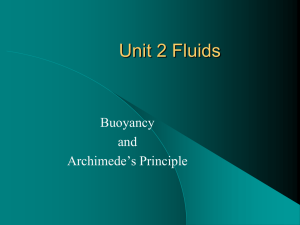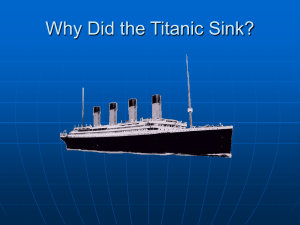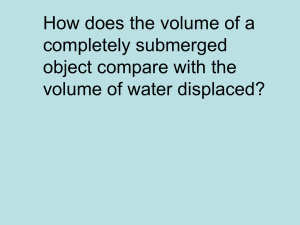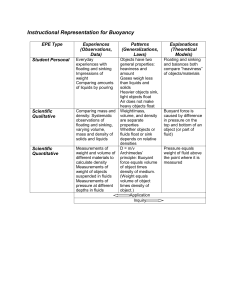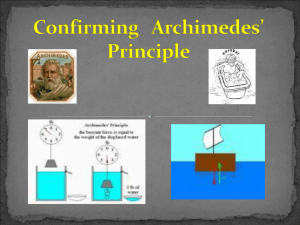unit2_6_Trieste worksheet teacher
advertisement
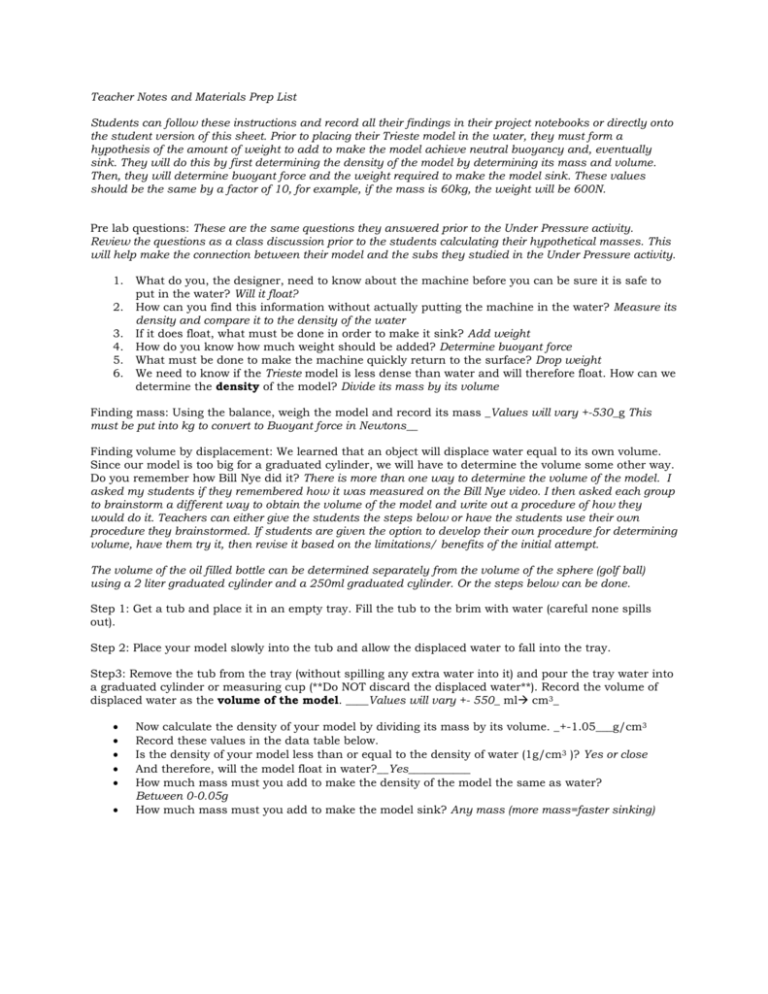
Teacher Notes and Materials Prep List Students can follow these instructions and record all their findings in their project notebooks or directly onto the student version of this sheet. Prior to placing their Trieste model in the water, they must form a hypothesis of the amount of weight to add to make the model achieve neutral buoyancy and, eventually sink. They will do this by first determining the density of the model by determining its mass and volume. Then, they will determine buoyant force and the weight required to make the model sink. These values should be the same by a factor of 10, for example, if the mass is 60kg, the weight will be 600N. Pre lab questions: These are the same questions they answered prior to the Under Pressure activity. Review the questions as a class discussion prior to the students calculating their hypothetical masses. This will help make the connection between their model and the subs they studied in the Under Pressure activity. 1. 2. 3. 4. 5. 6. What do you, the designer, need to know about the machine before you can be sure it is safe to put in the water? Will it float? How can you find this information without actually putting the machine in the water? Measure its density and compare it to the density of the water If it does float, what must be done in order to make it sink? Add weight How do you know how much weight should be added? Determine buoyant force What must be done to make the machine quickly return to the surface? Drop weight We need to know if the Trieste model is less dense than water and will therefore float. How can we determine the density of the model? Divide its mass by its volume Finding mass: Using the balance, weigh the model and record its mass _Values will vary +-530_g This must be put into kg to convert to Buoyant force in Newtons__ Finding volume by displacement: We learned that an object will displace water equal to its own volume. Since our model is too big for a graduated cylinder, we will have to determine the volume some other way. Do you remember how Bill Nye did it? There is more than one way to determine the volume of the model. I asked my students if they remembered how it was measured on the Bill Nye video. I then asked each group to brainstorm a different way to obtain the volume of the model and write out a procedure of how they would do it. Teachers can either give the students the steps below or have the students use their own procedure they brainstormed. If students are given the option to develop their own procedure for determining volume, have them try it, then revise it based on the limitations/ benefits of the initial attempt. The volume of the oil filled bottle can be determined separately from the volume of the sphere (golf ball) using a 2 liter graduated cylinder and a 250ml graduated cylinder. Or the steps below can be done. Step 1: Get a tub and place it in an empty tray. Fill the tub to the brim with water (careful none spills out). Step 2: Place your model slowly into the tub and allow the displaced water to fall into the tray. Step3: Remove the tub from the tray (without spilling any extra water into it) and pour the tray water into a graduated cylinder or measuring cup (**Do NOT discard the displaced water**). Record the volume of displaced water as the volume of the model. ____Values will vary +- 550_ ml cm3_ Now calculate the density of your model by dividing its mass by its volume. _+-1.05___g/cm3 Record these values in the data table below. Is the density of your model less than or equal to the density of water (1g/cm3 )? Yes or close And therefore, will the model float in water?__Yes___________ How much mass must you add to make the density of the model the same as water? Between 0-0.05g How much mass must you add to make the model sink? Any mass (more mass=faster sinking) Once students have the density of their model they can determine the hypothetical masses to add to it. Calculate the buoyant force that the water has on the model in order to answer the following questions. Form a hypothesis of how to make the model be neutrally buoyant and how to make it sink. Buoyant force is calculated in Newtons. Prior to students doing this part, make sure they understand how the weight of the displaced water will translate into a force value in Newtons (see supplemental reading assignment Buoyancy and Density). I did an example on the board using different numbers and then, had the students do the same calculations using their values. Pre lab Questions 1. 2. 3. 4. How is an object’s mass different from its weight? mass is a measurement of how much matter is in an object; weight is a measurement of how hard gravity is pulling on that object. Mass is constant in the universe, while weight is not because some planets lack gravity. Describe buoyant force? The force of water pushing up on an object or equal to the weight of water displaced State Archimedes’ Principle. Objects will displace water equal to their weight Will an object sink or float if its weight is less than its buoyant force? Float First, what do we need to know in order to determine the buoyant force? The weight of the displaced fluid, which in this case is water. The weight of water equals its volume and they already have that volume from the previous step when they determined the volume of the model. Now, determine the buoyant force of the water on your model. Since buoyant force is equal to the weight of water displaced, the value would be the same. For example, if 250ml of water is displaced, the weight is equal to 2.5N What amount of mass must be added to the Trieste Model in order to make it neutral? Subtract the mass of the model from the buoyant force. The result will tell you how much mass added to the model will make it neutral in water. By how much should this mass be increased in order to make the model sink to the bottom? Adding more mass will make it sink. Different groups can experiment by adding weight until it reaches the bottom. Blank data table from student worksheet on next page Now you can make an educated guess about the mass you need to add to the model for it to achieve neutral buoyancy and how much you need to add for it to sink. Record these numbers in your data table. Mass of model (g) +-530g Volume of model (cm3) +- 505 ml Density of model (m/v) +- 0.90g/cm3 Volume of displaced water (cm3) +-505ml Mass of displaced water (kg) **Note that mass must be in Kg Buoyant force of water (N) +-.505kg Weight to add for neutral buoyancy +- 5.05 N Buoyant force minus weight of model in kg Weight to add for sinking Anything more than what is calculated above Conclusion: Structure your conclusion paragraph by answering these questions Did the model float in the beginning? Did the model sink? Did the model rise back to the surface? What changed about the model to allow it to rise? Was your hypothesis correct? Was the mass to make the model sink equal to the weight that made it sink? What mass made your model neutral? Which changed in this experiment, the density of the model, or the buoyant force on the model? Explain this answer. How would your results change if the model were put in salt water? Explain. How could you make your model sink more slowly? Materials for each group of four students: Water bottle filled with canola oil Golf ball with hook eye 100ml and 250ml graduated cylinders Release mechanism (teacher made or student made) Paper clips Balance Rubber bands (2) Alka seltzer tablets (2-4) Equipment for the class Tall glass tanks Displacement tub Long stick with magnet attached to end About 3 gallons of canola oil 18-20 empty water bottles w/ caps 18-20 golf balls 18-20 rubber washers 18-20 hook eyes 1 box paper clips Hot glue gun 18-20 film canisters with lids (available on amazon.com) Drill with 1/8” bit and 1/16” bit Preparation before lab (if you choose, this can all be done by students) Create release mechanisms: Drill holes in caps, hook on paper clips Fill bottles with oil, glue on golf balls
